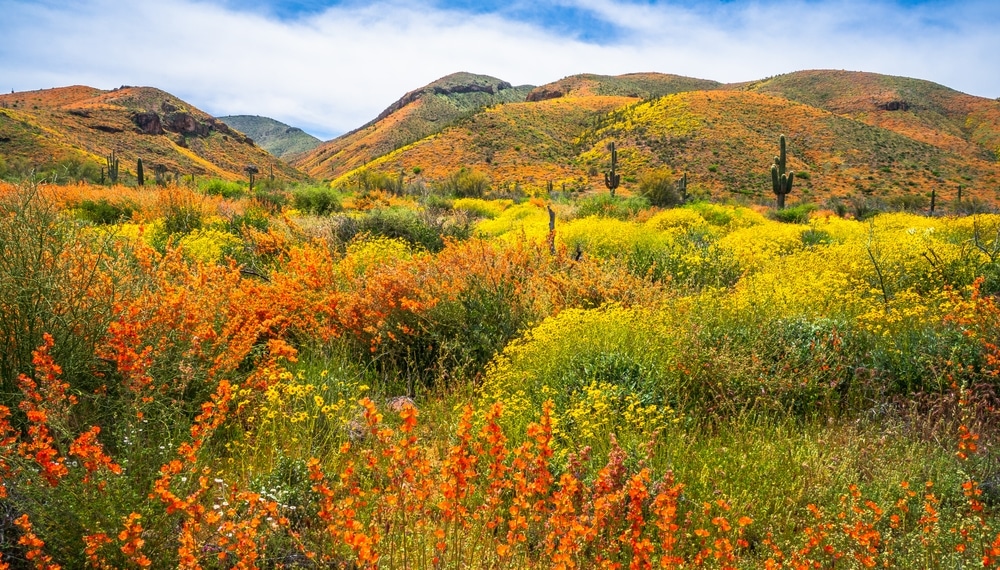Nestled in the rugged Sonoran Desert landscape of central Arizona, Tonto National Monument stands as a remarkable testament to the ingenuity and resilience of ancient peoples who once called this challenging environment home. Established in 1907 by President Theodore Roosevelt, this 1,120-acre monument protects and preserves well-preserved cliff dwellings built by the Salado culture during the 13th to early 15th centuries.
These architectural marvels, constructed within natural caves overlooking the expansive Roosevelt Lake and the surrounding Tonto Basin, offer visitors a unique glimpse into the past. The monument’s location, approximately 110 miles east of Phoenix near the town of Roosevelt, makes it an accessible yet often overlooked gem within Arizona’s impressive collection of public lands.
The monument not only safeguards these important archaeological sites but also protects a diverse desert ecosystem that has sustained human life for millennia. From towering saguaro cacti to delicate desert wildflowers, the natural setting provides both context for understanding the lives of the ancient Salado people and opportunities for modern visitors to connect with the Sonoran Desert landscape.
As part of the National Park Service system, Tonto National Monument represents an important piece of America’s commitment to preserving its natural and cultural heritage. This article explores what makes this small but significant monument worth visiting, from its fascinating historical significance to practical information for planning your trip.

The Lower Cliff Dwelling is the main attraction at Tonto National Monument. This well-preserved structure, built into a natural alcove, includes rooms that were once home to the Salado people. The 1-mile round-trip trail to the dwelling is moderately strenuous but offers stunning views of the surrounding desert and Roosevelt Lake. Rangers are often on-site to answer questions and provide historical context.
Start your visit at the Visitor Center, which features exhibits on the Salado people, their culture, and the environment of the Sonoran Desert. Artifacts such as pottery, tools, and textiles are on display, providing insight into the daily life of the ancient inhabitants. The Visitor Center also offers a short orientation film and a bookstore.
From both the monument and the hiking trails, you’ll enjoy stunning vistas of Roosevelt Lake, the largest lake in Arizona. The contrast between the blue water and the surrounding desert landscape makes for excellent photography and peaceful reflection.

The Upper Cliff Dwelling is larger and more remote than the Lower Cliff Dwelling and can only be visited on a guided tour. These tours, available seasonally (November through April), require reservations and offer a deeper exploration of the Salado culture and the monument’s history. The 3-mile round-trip hike is challenging but rewards visitors with breathtaking views and a glimpse into the past.

The Salado people were known for their advanced farming techniques and vibrant pottery. Interpretive signs along the trails and exhibits in the Visitor Center detail their way of life, including how they adapted to the harsh desert environment and interacted with neighboring cultures.

Rangers at Tonto National Monument host a variety of programs, including guided hikes, evening talks, and special events. These programs provide deeper insights into the monument’s history, geology, and unique desert ecosystem. Check the schedule at the Visitor Center for current offerings.

The monument offers shorter trails that allow visitors to explore the diverse flora and fauna of the Sonoran Desert. Along the way, you’ll encounter towering saguaro cacti, prickly pear, agave, and other desert plants, as well as lizards, birds, and other wildlife.

The diverse habitats of the Sonoran Desert and nearby Roosevelt Lake attract a variety of bird species, making Tonto National Monument a great spot for birdwatching. Look for cactus wrens, Gila woodpeckers, hawks, and other desert birds along the trails.
Tonto National Monument is a designated International Dark Sky Park, making it an excellent place for stargazing. On clear nights, visitors can see an incredible array of stars, planets, and the Milky Way. The monument occasionally hosts night sky events with telescopes and expert guides.

The monument features a picnic area where visitors can relax and enjoy a meal surrounded by the serenity of the desert. Bring your own food and take in the beautiful views of the cliffs and lake.

Tonto National Monument is part of the Tonto Basin area, which is rich in history and natural beauty. Combine your visit with nearby attractions like Roosevelt Dam, the Apache Trail Scenic Drive, or Tonto Natural Bridge State Park for a full day of exploration.

| Category | Details |
|---|---|
| Location | Near Roosevelt, Arizona, USA |
| Established | October 21, 1907 |
| Managed By | National Park Service |
| Size | Approximately 1,120 acres (453 hectares) |
| Main Attractions | Upper Cliff Dwelling, Lower Cliff Dwelling, Tonto Basin |
| Cultural Significance | Preserves Salado culture cliff dwellings from the 13th–15th centuries (approx. 1250–1450 CE) |
| Time Period | Dwellings date from approximately 1250–1450 CE |
| Geology | Located in the Sonoran Desert, near steep cliffs and Roosevelt Lake |
| Ecosystem | Sonoran Desert with saguaro cacti, palo verde trees, and desert wildlife |
| Nearby Landmarks | Roosevelt Dam, Tonto Basin, Apache Trail Scenic Drive |
| Visitor Activities | Hiking, guided tours, birdwatching, photography, and cultural exhibits |
| Climate | Hot summers, mild winters, with limited rainfall |
| Entrance Fee | $10 per adult (children under 16 free; fees subject to change) |
| Accessibility | Lower Cliff Dwelling trail is moderately accessible; Upper Cliff Dwelling requires a strenuous hike |
| Fun Fact | The cliff dwellings were built to take advantage of natural defensive positions and views of the Tonto Basin. |
The cliff dwellings at Tonto National Monument were constructed by the Salado people, a prehistoric culture that flourished in the Tonto Basin between approximately 1250 and 1450 CE. The Salado culture emerged from a blending of Hohokam and Ancestral Puebloan traditions, creating a distinct cultural identity recognized particularly by their polychrome pottery with distinctive red, black, and white designs.
The monument preserves two primary cliff dwelling sites:
Lower Cliff Dwelling: The more accessible of the two sites, featuring about 20 rooms built within a natural alcove about 100 feet above the canyon floor. This dwelling once housed approximately 15-20 people.
Upper Cliff Dwelling: A larger complex of about 40 rooms, requiring a guided tour to visit. This more elaborate dwelling housed around 40-60 people and showcases more sophisticated construction techniques.
Both dwellings demonstrate remarkable architectural skill, with multi-story structures built using locally sourced materials. The builders used limestone rocks, mud mortar, and wooden beams from native trees such as juniper and sycamore. Interior walls were finished with smooth mud plaster, some areas still showing evidence of decorative elements.
The Salado people were skilled farmers who developed sophisticated agricultural systems to grow crops in the desert environment. Archaeological evidence reveals extensive terracing and irrigation systems that channeled limited rainfall to cultivate corn, beans, squash, and cotton. These agricultural practices were supplemented by gathering wild plants like mesquite pods, saguaro fruits, and agave.
The cliff dwellings themselves provide insights into daily life. Room configurations suggest specialized spaces for food storage, cooking, sleeping, and ceremonial activities. Artifacts recovered from the site include:
The strategic positioning of the dwellings offered both protection from enemies and environmental advantages. The natural caves provided shelter from summer heat and winter cold, while their elevated position offered defensive advantages and panoramic views of the surrounding territory.
Several contemporary Native American tribes maintain cultural connections to the Salado people and the Tonto Basin area. The O’odham, Hopi, Zuni, and Western Apache peoples all have traditional ties to this region and consider these archaeological sites part of their cultural heritage. The National Park Service works collaboratively with these affiliated tribes to interpret the site’s history and ensure respectful presentation of cultural materials.
Tonto National Monument showcases the ecological diversity of the Sonoran Desert, one of North America’s most biologically rich desert ecosystems. The monument spans several elevation zones, creating microhabitats that support a surprising variety of plant and animal species.
The monument’s flora includes:
Wildlife within the monument boundaries includes:
The monument’s striking landscape has been shaped by millions of years of geological processes. The cliff dwellings themselves are nestled in natural caves formed within layers of sedimentary rock. The surrounding terrain features:
This complex geological setting not only provided ancient peoples with natural shelter but continues to offer modern visitors dramatic vistas and opportunities to understand how landscape shaped human adaptation.
The primary attraction at Tonto National Monument is experiencing the ancient cliff dwellings firsthand. Visitors have several options:
Both experiences offer intimate encounters with these well-preserved structures and opportunities to learn about the people who built them. Visitors can observe original architectural features, including intact wooden beams, doorways, windows, and storage spaces.
The monument’s visitor center serves as an excellent starting point for any visit. Facilities include:
The museum displays include examples of Salado polychrome pottery, tools, textiles, and explanations of construction techniques used in the dwellings. Interactive exhibits help visitors understand how archaeologists have interpreted the site and what life might have been like for its ancient inhabitants.
While the cliff dwellings are the primary attraction, the monument offers additional recreational opportunities:
Tonto National Monument offers various educational opportunities:
The monument experiences extreme summer temperatures that can make hiking uncomfortable and potentially dangerous. The recommended visiting seasons are:
Comfortable temperatures, fewer visitors
Mild daytime temperatures, potential for occasional cold or rainy days
Ideal weather, wildflower displays, highest visitation
Extremely hot, afternoon thunderstorms during monsoon season (July-August)
Morning visits are recommended year-round for cooler temperatures and better lighting for photography. The monument tends to be busiest on weekends and holidays, particularly during spring months.
The desert environment requires specific safety precautions:
The monument has made efforts to accommodate visitors with varying abilities:
The monument is relatively remote, with limited services in the immediate vicinity:
The monument is accessible by vehicle:
Tonto National Monument faces several ongoing conservation challenges:
The National Park Service implements various programs to address these challenges:
Visitors play an important role in preserving Tonto National Monument for future generations:
Tonto National Monument offers a remarkable opportunity to connect with both ancient human history and the enduring natural beauty of the Sonoran Desert. Though smaller and less visited than some of Arizona’s more famous national parks, the monument provides an intimate and educational experience that showcases the remarkable adaptability of human cultures in challenging environments.
The well-preserved cliff dwellings stand as silent testimonials to the ingenuity of their builders, while the surrounding landscape continues to demonstrate the biological diversity that has sustained life in this region for millennia. For visitors seeking to understand Arizona’s rich cultural heritage and diverse ecosystems, Tonto National Monument represents an essential destination.
Whether you’re an archaeology enthusiast, a nature lover, or simply looking to explore less-traveled paths through Arizona’s public lands, Tonto National Monument rewards visitors with authentic experiences and lasting impressions. By approaching this special place with respect and curiosity, modern visitors become part of the ongoing story of human connection to this remarkable landscape.
We use cookies to improve your experience on our site. By using our site, you consent to cookies.
Manage your cookie preferences below:
Essential cookies enable basic functions and are necessary for the proper function of the website.
Statistics cookies collect information anonymously. This information helps us understand how visitors use our website.
Marketing cookies are used to follow visitors to websites. The intention is to show ads that are relevant and engaging to the individual user.